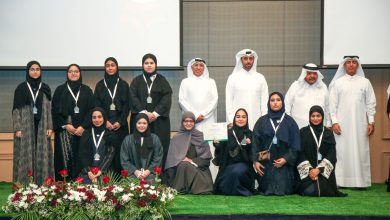
QNL Shine A Spotlight On Plagues And Pandemics Of The Past
مكتبة قطر الوطنية توثق تاريخ الطواعين والأوبئة في العالم الإسلامي
Doha: The crisis the whole world has been experiencing over the last year caused by COVID-19, or the coronavirus, is not the first time a pandemic has threatened the lives and livelihoods of human beings. And as an amazing collection of rare books and original manuscripts housed in Qatar National Library reveals, the Muslim and Arab world knew the devastating damage plagues, epidemics and pandemics could inflict.
The Library’s manuscript specialist, Mahmoud Zaki, has been carrying out detailed research through the treasures of the Heritage Library and beyond and has unearthed some extraordinary facts about how past inhabitants of this region managed to survive through those terrible times and live to tell their tales. While his work is yet to be published on the Library’s blog, a lecture recording can be accessed on the website, and some of these materials are also available through the Library’s Digital Repository (http://ediscovery.qnl.qa/).
“The history of mankind has witnessed many outbreaks of plagues, epidemics and pandemics,” Zaki says. “In Islamic history, these outbreaks are generally referred to by the Arabic word Ta’un, meaning ‘plague’ and to widespread outbreaks by the words Al Tu’an Al Kabir – ‘the big plague’ – or Al Jaref – ‘the sweeping plague’.
“The isolation imposed on or chosen by Arab and Muslim scholars and authors who witnessed these epidemics led to a large number of texts that are wholly devoted to the subject of epidemics and plagues. They discussed these calamities through medical and theological perspectives, sociohistorical and literary narratives, and general books of Hadith (Prophet’s traditions), Fiqh (Islamic jurisprudence) and medicine. The individual experiences of those who lived through these plagues were clearly present in their works, each according to their discipline and profession.”
Infection caused by plagues and precautions against them are among the earliest writings on the subject. Some date back to the ninth century CE and include an essay by Al-Kindi on “Incenses Purging The Atmosphere Against Epidemics”; “An Essay On Plagues,” by Ibn Abi Al-Dunya; and Ibn Al-Jazzar’s “Causes Generating Epidemics In Egypt.” While all three texts were lost, a later extended text, “Survival Material About Treating Air Spoilage And Avoiding Harms Of Epidemics” was published in 1999, from the latter part of the 10th century CE and attributed to Muhammad Al-Tamimi, also sheds light on the matter.
The catastrophic bubonic plague that is believed to have claimed the lives of as many as 200 million people across Afro-Eurasia between 1346 and1353 CE—known as the Black Death—also features in the available literature. Medieval historian Al-Maqrizi, who was born just a little over a decade after the end of the horrendous event, declared that it originated in China. According to the Egyptian-born scholar’s writings, this plague “covered the regions of the whole world, east and west, north and south, and inflicted all races descended from Adam, and other beings including even fish, birds of the sky and beast animals on the ground.”
Another Arab scholar preceding Al-Maqrizi, Tunisian-born Ibn Khaldun, also recorded with tremendous power about the toll of misery the Black Death brought. He wrote: “Civilization in both the East and the West was visited by a destructive plague which devastated nations and caused populations to vanish. It swallowed up many of the good things of civilization and wiped them out. Cities and buildings were laid waste, roads and way signs were obliterated, settlements and mansions became empty, dynasties and tribes grew weak. The entire inhabited world changed.”
Further manuscripts authored by historians Ibn Khatima and Lisan Al-Din Ibn Al-Khatib, who both lived in Muslim Spain in the 14th century CE, reveal their beliefs about contagion—notably, that taking precautions and preventatives measures did not contradict trust in Allah. Ibn Al-Khatib, in fact, wrote: “To ignore the proofs for plague contagion is an indecency and an affront to God and holds cheap the lives of Muslims”.
Zaki’s research has also uncovered other authors from the tumultuous time who wrote about the plague, including Syrian-born Ibn Al-Wardi, Arabian biographer Assafadee and Egyptian scholar Taj Al-Din Al-Subki. All lost their lives due to the Black Death or associated causes.
Perhaps one of the most important and influential works of the century that followed the Black Death is by Cairo-born Islamic scholar Ibn Hajar Al-Asqalani.
The work, An Offering Of Kindness On The Virtue Of The Plague, is one of the most famous Arabic works on plagues, and was used and drawn upon by many succeeding authors and scholars. Al-Asqalani was a renowned Muslim scholar of Hadith and a historian who lived during the time of plagues. Due to one plague, he lost two of his daughters, followed by his eldest daughter, who died while pregnant during the Black Death. Besides his devastating losses, Al-Asqalani endured other plagues and became ill in one, though he recovered.
Says Zaki: “Like many other scholars, Al-Asqalani structured his book around the Prophet’s traditions and attributed narrations with that containing a set of directions and guiding in brief words. The most important of these narrations are: ‘Allah has sent down both the disease and the cure for every disease, so treat yourselves medically, but avoid any untoward methods; ‘Allah does not send down any disease but He also sends down a remedy with it’; ‘Those who are sick infected with contagious diseases should be kept away from those who are healthy’; ‘If you hear about it (an outbreak of plague) in a land do not go to it, but if a plague breaks out in your own neighborhood, do not run away from it’; and ‘Anyone (among the believers) who stays in his home patiently in the time of an epidemic plague hoping for Allah’s Reward and believing that nothing will befall him except what Allah has written for him, will get the reward of a martyr.’”
The Library’s extensive collection of manuscripts also includes The Shield From Plague And Epidemic, written by 16th-century CE Spanish-born Jewish scholar and physician, Elias Ben Ibrahim. The manuscript was written in 1558 CE/996 AH in Ottoman Budin Province (currently situated in Slovakia, Hungary, Croatia, and Serbia).
Zaki says: “Ben Ibrahim commentated in detail on the plague fever, citing the experience of his fellow physicians, and comparing their treatments with those of Muslim physicians, including Ibn Sina, regarded as the father of early modern medicine, who lived in the late 10th and early 11th centuries CE. He referred to the response of Christian physicians and their decision to flee from the plague, and detailed the health measures that could be taken to be protected from the plagues, such as the use of a piece of cloth moistened with vinegar, rose water and sandalwood, highlighting the importance of the patient’s mental health in coping with epidemics. He quoted Plato, saying: ‘A skilled physician must treat the mood that is predisposed to a disease before the occurrence of that disease.’”
Responses to today’s global pandemic caused by the coronavirus remain very much uppermost in people’s thoughts, not just across Qatar but all over the world. With the Library’s incredible wealth of documents on plagues of the past available to see, it may be comforting to remember that these terrible events did not last forever, and normal life did eventually return for those who came before us.
الدوحة: لم تكن الأزمة التي اجتاحت العالم من جرَّاءِ جائحة فيروس كورونا (كوفيد-19) هي المرة الأولى التي تذوق فيها البشرية ويلات الأوبئة والطواعين التي هددت حياتهم وقطعت معايشهم وأرزاقهم، إذ تكشف مجموعة مذهلة من النصوص والوثائق التراثية، بعضها متوفر في المكتبة التراثية بمكتبة قطر الوطنية بأصولها الورقية وبصيغة رقمية كذلك، أن العلماء العرب والمسلمين قد عاصروا هذه الطواعين والأوبئة وجربوا آلامها ومعاناتها، بل وصنفوا فيها العديد من المؤلفات والكتب التي وثقوا فيها حياتهم تحت وطأتها ودونوا فيها ملاحظاتهم ومشاهداتهم حولها.
أعدّ محمود زكي، أخصائي المخطوطات في المكتبة التراثية، دراسة وألقى محاضرة عرَّف فيها بعدد من المخطوطات النفيسة والنادرة بالمكتبة التراثية وبمكتبات عالمية أخرى، التي تكشف عن بعض الحقائق المهمة والطريفة حول تعامل العرب والمسلمين عبر تاريخهم القديم مع الأوبئة والطواعين، وكيف نجوا من هذه الأمراض الرهيبة التي فتكت بالملايين ليكتبوا قصصهم وحكاياتهم عن الأحباء الذين فقدوهم والعزلة التي فرضتها عليهم. واليوم تبدو تجاربهم المؤلمة مألوفة جدًا وكأنها كتبت بالأمس القريب بعد أن عاش العالم كله محنة العزلة بسبب جائحة كورونا التي فقد العالم فيها حتى الآن ما يزيد عن مليوني نفس.
يمكن مشاهدة تسجيل المحاضرة التي ألقاها محمود زكي عبر الموقع الإلكتروني للمكتبة، كما تتوفر بعض المخطوطات التي تناولها متاحة للاطلاع في المستودع الرقمي (http://ediscovery.qnl.qa).
يقول محمود زكي: “شهد تاريخ البشرية العديد من الأوبئة والجوائح، ومنه التاريخ الإسلامي، وغالبًا ما كان يطلق عليها عمومًا اسم «الطَّاعون» أو للجوائح منها «الطاعون الكبير» أو «الجارف». وقد نتج عن العزلة التي فُرضت على العلماء والمؤلِّفين العرب والمسلمين الذين عاصروها أو اختاروها بأنفُسهم عددٌ كبيرٌ من المؤلَّفات المُفردة في موضوع الأوبئة والطواعين، منها ما تناول هذه النوازل من جانبٍ طبيّ، ومنها الشرعيّ الدينيّ، إضافةً إلى السرد التاريخيّ -الاجتماعيّ والأدبيّ، فضلًا عما وقع تناوله ضمن كتب الحديث والفقه والطب. وكانت التجارب الفردية لمن عايشوا هذه الطواعين حاضرةً بجلاء في أعمالهم، كلٌّ منهم حسب مجال تخصُّصه”.
كان جدل العدوى التي تسببها الأوبئة والطواعين، والاحتراز منها، موضوع التآليف العربية التاريخية في الطاعون. ومن المؤلَّفات المـُبكِّرة في هذا الموضوع رسالة الكندي (توفي نحو 260 هـ/873 م) في «الأَبْخِرَة المـُصْلِحَة للجو من الأوباء»، و«كتاب الطواعين» لابن أبي الدنيا (توفي 281 هـ/894 م)، و«نعت الأسباب الموَّلِّدَة للوباء في مصر» لابن الجزار (توفي 395 هـ/890 م)، وكتاب «مادة البقاء بإصلاح فساد الهواء والتحرز من ضرر الأوباء» لمحمد التميمي (توفي نحو 390 هـ/990 م).
الطاعون الكبير أو «الموت الأسود» كان أيضًا حاضرًا بقوة في كتابات العلماء المسلمين، وقد تسبَّب في موت نحو 200 مليون إنسان في أوروبا وآسيا بين عامي 1346 و1353، وكان هذا الطاعون قد وصل إلى العالم الإسلامي 1348 م. وقد ذكر المؤرَّخ المقريزي الذي ولد في 766 هـ / 1364م أي بعد مرور عشر سنوات على انتهاء هذا الطاعون؛ أن ابتداءه كان في الصين، وأنه لم يكن مثل الطواعين السابقة بل «عمَّ أقاليم الأرض شرقًا وغربًا، وشمالًا وجنوبًا، جميع أجناس بني آدم، وغيرهم حتى حيتان البحر، وطير السماء، ووحش البرّ».
أما المؤرخ التونسي المولد عبد الرحمن بن خلدون فقد وصف في مقدمته الشهيرة الخسائر الهائلة التي أنزلتها كارثة الموت الأسود بالبشرية وصفا بليغًا بقوله: “نزل بالعمران شرقًا وغربًا في منتصف هذه المائة الثامنة من الطاعون الجارف الذي تحيَّف الأُمم وذهب بأهل الجيل، وطوى كثيرًا من محاسن العُمران ومَحاها، وجاء للدول على حين هَرَمِها وبلوغ الغاية من مَداها، فقلَّص من ظِلالها، وفَلَّ من حَدِّها، وأَوْهَنَ من سُلطانها، وتداعَتْ إلى التَّلاشي والاضمحلال أحوالُـها، وانتقض عمران الأرض بانتفاض البَشَر، فخَرِبَت الأمصار والمصانع، ودَرَسَت السُّبُل والمعالم، وخلت الديار والمنازل، وضَعُفت الدُّول والقبائل.. فكأنـَّما تَبدَّل الخَلْقُ من أصْله، وتحوَّل العالم بأسْره، وكأنه خَلْقٌ جديدٌ، ونشأةٌ مُستأْنَفَةٌ”.
أشار عدد من علماء المسلمين إلى مفهوم العدوى وأنها السبب في انتشار الأوبئة والطواعين، ومنهم ابن خاتمة ولسان الدين ابن الخطيب، اللذين عاشا في الأندلس في القرن الثامن الهجري/الرابع عشر الميلادي، وصرَّحا بثبوت وجود العدوى في المرض «بالتجربة والاستقراء والحسّ، والمشاهدة والأخبار المتواترة»، وضرورة الاحتراز واتخاذ الأسباب، وأن ذلك لا يُعارِض التوكل على الله. بل وصف ابن الخطيب القول بخلاف ذلك بأنَّه «زَعارَةٌ وتَصاقُرٌ على الله، واسترخاصٌ لنفوس المسلمين».
وأشارت الدراسة البحثية التي أعدها محمود زكي إلى علماء ومؤلفين آخرين ممن عاصروا الطاعون الأكبر، ومنهم من مات به أو بطاعون لاحق أو بأسباب متصلة به بعد تأليفه عنه، مثل ابن الوردي (توفي 749 هـ) والصَّفَدِي (توفي 764 هـ) الذي كتب فيه مقامةً أدبيةً كذلك، وتاج الدين السُّبْكِي (توفي 771 هـ) وابن أبي حَجَلَة التِّلِمْساني (توفي 776 هـ)، الذي ألَّف في الطاعون رسالته المختصرة «الطب المسنون في دفع الطاعون».
يُعدُّ كتاب «بذل الماعون في فضل الطاعون» من أشهر الأعمال العربية في الطاعون، التي بني عليها واعتمدها كثيرٌ مما كتب بعده، اختصارًا وتهذيبًا، مثل السيوطي (توفي 911 هـ / 1505 م) وغيره. وهو من تأليف ابن حَجَر العَسْقَلاني (توفي 852 ه/1449 مـ) المُحّدِّث والمؤرخ المعروف الذي عاش في عصر المماليك في مصر والشام، وعاصر عدة طواعين. وفقد بسبب طاعون سنة 819 ه ابنتيه غالية وفاطمة، ثم فقد ابنته الكبرى زين خاتون التي توفيت وهي حامل أثناء الطاعون (الكبير) الذي وقع سنة 833 ه، فضلًا عما عاصره هو من طواعين أخرى، وتجربته الشخصية بإصابته بالمرض ثم شفائه منه. والمخطوط متوفر بصيغة رقمية عبر المستودع الرقمي للمكتبة (http://ediscovery.qnl.qa/).
في دراسته البحثية، يوضح محمود زكي أن ابن حجر قد بنى كتابه ومناقشاته على عددٍ من الأحاديث النبوية والمرويات المـُسْنَدة التي تُعطي جملةً من التوجيهات والرسائل المفيدة بكلمات موجزة من أهمها «إنَّ اللهَ أنزَلَ الدَّاءَ والدَّواءَ، وجعَل لكلِّ داءٍ دواءً، فتَداوَوْا، ولا تَداوَوْا بِحَرامٍ». [سنن أبي داود]، و«ما أنزَلَ اللهُ عزَّ وجلَّ مِن داءٍ إلَّا أنزَلَ معه شِفاءً -وقال عَفَّانُ مَرَّةً: إلَّا أنزَلَ له شِفاءً- عَلِمَه مَن عَلِمَه، وجَهِلَه مَن جَهِلَه». [مسند أحمد] و«لاَ يُورِدُ المــُمْرِضُ عَلَى المــُصِحِّ». [صحيحي البخاري ومسلم]. أي: لا يُؤتَى بمريضٍ على صَحيحٍ سَليمٍ؛ مخافَةَ أن يُعديَه. «ليس مِن رَجُلٍ يَقَعَ الطاعونُ فيَمكُثُ في بيته صابِرًا مُحتَسِبًا يَعلَمُ أنَّه لا يُصيبُه إلَّا ما كَتَبَ اللهُ له إلَّا كان له مِثلُ أجْرِ الشَّهيدِ». [البخاري].
ويذكر محمود زكي أن مكتبة قطر الوطنية تحتفظ بنسخة مخطوطة نفيسة من كتاب العسقلاني كُتبت بالمسجد الأقصى بفلسطين سنة 864 هـ / 1460 م، أي بعد اثني عشر سنةً من وفاة المؤلف، وإحدى وثلاثين سنةً من تاريخ تأليفه لها (سنة 833 هـ)، كما تقتني مكتبة قطر الوطنية مخطوطا نادرًا بعنوان «مِجَنَّة الطاعون والوَباء» لإلياس بن إبراهيم الإسباني، ألَّفها سنة 915 هـ / 1509 م للسلطان العثماني بايزيد الثاني، وهذا المخطوط متوفر أيضًا بصيغة رقمية عبر المستودع الرقمي للمكتبة (http://ediscovery.qnl.qa/).
يُعلِّق محمود زكي على هذا المخطوط قائلًا: “فصَّل ابن إبراهيم الإسباني الكلام على الحُمَّى الوبائية، ونقل تجارب علماء بلده، مقارنًا بين علاجاتهم وعلاجات المسلمين ومنهم الشيخ الرئيس ابن سينا. وممَّا تعرَّض له موقف أطباء النصارى واختيارهم الفرار من الطاعون. كما ذكر جملةً من التدابير الصحية التي يمكن اتخاذها للوقاية من الأوبئة، ومن ذلك مثلاً استخدام خِرْقَة (قطعة قُماش) مُبلَّلة بالخلِّ وماء الورد والصَّندل. واعتنى ببيان أهمية الصحة النفسية للمريض في مواجهة الأوبئة، فنقل عن أفلاطون قوله: «ويجب على الطبيب الحاذق أن يعالج المزاج المستعد لمرضٍ قبل حدوث ذلك المرض».
ستظل مكافحة جائحة فيروس كورونا الحالية الشاغل الأكبر الذي يستحوذ على القدر الأكبر من أفكار الناس وأولوياتهم لفترة طويلة ليس فقط في قطر بل في جميع دول العالم قاطبة. وربما نجد العزاء فيما تخبرنا به ذخائرالمكتبة التراثية من مخطوطات القدماء ومؤلفاتهم حول الأوبئة والطواعين الماضية، إذ تذكرنا أن هذه الأمراض الرهيبة والأوبئة الفتاكة لم تستمر للأبد، وأن الحياة الطبيعية لن تلبث أن تعود كما عادت لمن عاشوا قبلنا.







